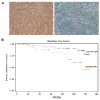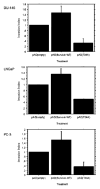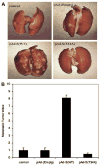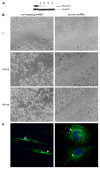Survivin is a potential mediator of prostate cancer metastasis
- PMID: 20231071
- PMCID: PMC4348096
- DOI: 10.1016/j.ijrobp.2009.09.007
Survivin is a potential mediator of prostate cancer metastasis
Abstract
Purpose: We examined whether Survivin expression is associated with an increased risk of metastasis in prostate cancer.
Methods and materials: A total of 205 patients with T1 (23%) and T2 (77%) prostate cancer were treated with conventional external beam radiation therapy from 1991 to 1993 at the Massachusetts General Hospital. Of the patients, 62 had adequate and suitable-stained tumor material for Survivin analysis. Median follow-up was 102 months (range, 5-127 months). Distant failure was determined on the basis of clinical criteria. In preclinical studies, replication-deficient adenovirus encoding phosphorylation-defective Survivin Thr34→Ala dominant-negative mutant pAd-S(T34A) or short hairpin RNA (shRNA) was used to inhibit Survivin in prostate cancer models, and the cell motility, morphology, and metastasis were investigated.
Results: Our correlative data on men with early-stage (T1/T2) prostate cancers treated at Massachusetts General Hospital by definitive radiotherapy indicated that overexpression of Survivin (positive staining in ≥10% cells) was associated with a significantly increased risk for the subsequent development of distant metastasis (p = 0.016) in the univariate analysis. In the multivariate analysis, overexpression of Survivin remained an independent predictor of distant metastasis (p = 0.008). The inhibition of Survivin dramatically inhibited invasiveness of prostate cancer cells in the in vitro invasion assay and spontaneous metastasis in the Dunning prostate cancer in vivo model. Furthermore, attenuation of Survivin resulted in changes in the microtubule cytoskeleton, loss of cellular polarity, and loss of motility.
Conclusions: This study suggests that Survivin may be a potentially important prognostic marker and promising therapeutic target in metastatic prostate cancer.
Copyright © 2010 Elsevier Inc. All rights reserved.
Conflict of interest statement
Conflict of interest: none.
Figures




Similar articles
-
Adenovirus-mediated inhibition of survivin expression sensitizes human prostate cancer cells to paclitaxel in vitro and in vivo.Prostate. 2005 Aug 1;64(3):293-302. doi: 10.1002/pros.20263. Prostate. 2005. PMID: 15754318
-
Therapeutic targeting of the survivin pathway in cancer: initiation of mitochondrial apoptosis and suppression of tumor-associated angiogenesis.Clin Cancer Res. 2003 Jul;9(7):2683-92. Clin Cancer Res. 2003. PMID: 12855648
-
Survivin mediates resistance to antiandrogen therapy in prostate cancer.Oncogene. 2005 Apr 7;24(15):2474-82. doi: 10.1038/sj.onc.1208490. Oncogene. 2005. PMID: 15735703
-
Survivin is not only a death encounter but also a survival protein for invading tumor cells.Front Biosci. 2007 Jan 1;12:1260-70. doi: 10.2741/2144. Front Biosci. 2007. PMID: 17127378 Review.
-
The role of survivin for radiation therapy. Prognostic and predictive factor and therapeutic target.Strahlenther Onkol. 2007 Nov;183(11):593-9. doi: 10.1007/s00066-007-1800-4. Strahlenther Onkol. 2007. PMID: 17960333 Review.
Cited by
-
Early Cellular Responses of Prostate Carcinoma Cells to Sepantronium Bromide (YM155) Involve Suppression of mTORC1 by AMPK.Sci Rep. 2019 Aug 8;9(1):11541. doi: 10.1038/s41598-019-47573-y. Sci Rep. 2019. PMID: 31395901 Free PMC article.
-
Physcion 8-O-β-glucopyranoside induces mitochondria-dependent apoptosis of human oral squamous cell carcinoma cells via suppressing survivin expression.Acta Pharmacol Sin. 2016 May;37(5):687-97. doi: 10.1038/aps.2015.152. Epub 2016 Apr 11. Acta Pharmacol Sin. 2016. PMID: 27063218 Free PMC article.
-
Cloning, Expression, and Purification of the Human Synthetic Survivin Protein in Escherichia coli Using Response Surface Methodology (RSM).Mol Biotechnol. 2023 Mar;65(3):326-336. doi: 10.1007/s12033-021-00399-4. Epub 2021 Sep 26. Mol Biotechnol. 2023. PMID: 34564769
-
Immunohistochemical expression and serum level of survivin protein in colorectal cancer patients.Oncol Lett. 2016 Nov;12(5):3591-3597. doi: 10.3892/ol.2016.5075. Epub 2016 Sep 1. Oncol Lett. 2016. PMID: 27900041 Free PMC article.
-
Inhibition of skeletal growth of human prostate cancer by the combination of docetaxel and BKM1644: an aminobisphosphonate derivative.Oncotarget. 2016 May 10;7(19):27489-98. doi: 10.18632/oncotarget.8481. Oncotarget. 2016. PMID: 27050371 Free PMC article.
References
-
- Jemal A, Siegel R, Ward E, et al. Cancer statistics, 2008. CA Cancer J Clin. 2008;58:71–96. - PubMed
-
- Chakravarti A, Zhai GG. Molecular and genetic prognostic factors of prostate cancer. World J Urol. 2003;21:265–274. - PubMed
-
- Gopalkrishnan RV, Kang DC, Fisher PB. Molecular markers and determinants of prostate cancer metastasis. J Cell Physiol. 2001;189:245–256. - PubMed
-
- Altieri DC. Validating survivin as a cancer therapeutic target. Nat Rev Cancer. 2003;3:46–54. - PubMed
Publication types
MeSH terms
Substances
Grants and funding
LinkOut - more resources
Full Text Sources
Medical

